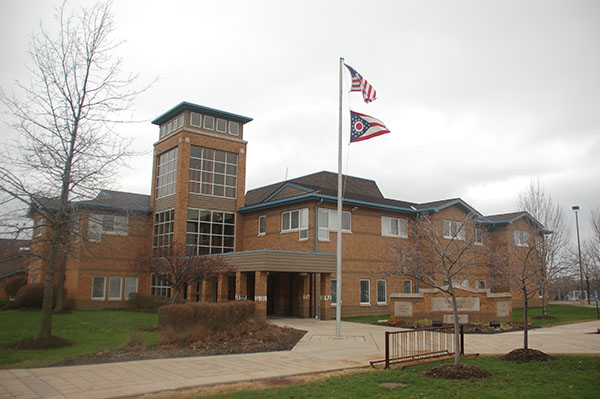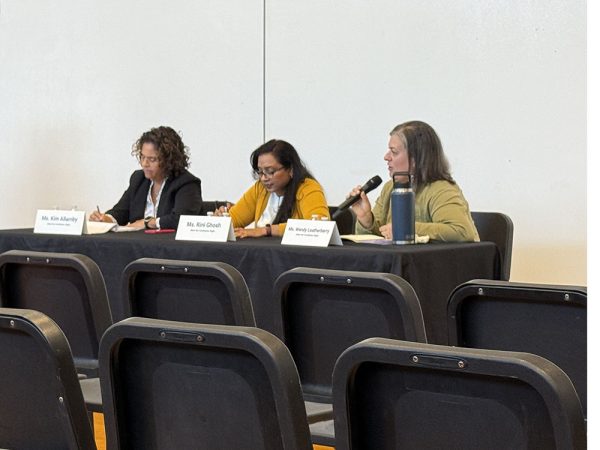Voters Approve 5.9-Mill Operating Levy

After the preschool moves to Bryden, Hardis and Walsh see the Fairmount building as a space to be shared with the community.
Beachwood voters passed issue 2, a 5.9-mill operating levy, on Nov. 6.
Unofficial results from the Cuyahoga County Board of Elections show that 3,558 people voted for the levy while 2,442 voted against it.
According to District Treasurer and Director of Finance Michele Mills, while voters approved the levy, it was by a lower margin than previous levies.
In May, the combined 8.7-mill operating and bond levy failed by only five votes. In addition to increasing funding for the schools, the combined levy would have allowed for the demolition of Bryden and Hilltop and the construction of a new consolidated elementary school at the Fairmount School site.
Superintendent Dr. Robert Hardis was more optimistic about Issue 2’s success going into November.
“After being cautiously optimistic, I was relieved and very thankful that it passed,” he said.
This time, Issue 2 contained only the operating levy, which would generate $4.3 million in operating funds for the schools.
The operating levy pays for the day-to-day expenditures of running Beachwood schools, such as educational materials and supplies, utility bills, staff salaries, buses and computers, and offsets funding loss from the state.
The operating levy will also extend by 4-5 years the length of time before additional funding is needed.
“A number of budget bills have been very detrimental financially to [schools], and the only place that we can increase our revenues is to go ask the taxpayers,” Mills said.
Budget reductions were made in many of the district’s programs and services, totaling about $500,000.
“We made some cuts to prepare for the possibility that there wouldn’t be enough funds to do everything that we needed to do,” School Board President Dr. Brian Weiss said.
However, the cuts were small and spread out in order to limit their effects as much as possible.
“We wanted to make sure that a student’s experience in the classroom didn’t feel different,” Hardis said. “This way, students don’t lose a program they wanted to be a part of.”
Some reductions, such as delaying purchasing another bus, will not be reversed. Other cuts will be reviewed.
As of now, no decisions have been made yet.
“We are going to study this issue… and we will make some informed decisions as to what is needed,” Mills said. “We really want to look out on the horizon. School funding won’t get any rosier and my job is—to the best of my ability—to achieve long-term financial stability for the district.”
“We have to do everything we can to elongate the levy cycle, so we are committed to looking at all our expenditures going forward,” she added.
According to administrators, the district will lose $3.5 million a year beginning in 2019 due to cuts by the state legislature and governor.
Out of the $3.5 million, $2.5 million is being lost through the elimination of the Tangible Personal Property (TPP) tax, a tax on businesses that yielded local dollars for schools. The TPP tax was eliminated in order to incentivize businesses to stay in Ohio.
“About a decade ago, Beachwood was collecting $5.2 million a year from TPP taxes, which was wonderful revenue to have because it cost Beachwood residents nothing,” Hardis said.
TPP taxes began to phase out in 2005 and were eliminated entirely in 2015. However, because the legislature knew that schools relied heavily on the TPP as a funding source, it was replaced with a supplement that offset the losses.
In 2017, Governor Kasich line-item vetoed the supplement, stating that schools have had “more than sufficient time to prepare for the end of this funding.”
The supplement will be eliminated completely in 2019.
“This tax year, we will collect $340,000 of what used to be $5.2 million and was then reduced to $2.5 million,” Hardis said. “Next year, it’s gone.”
The state has also cost-shifted $1 million in educational funding back to the district, expenditures that the schools have no control over.
Hardis said that over the last several years, there has been an increasing number of unfunded state government mandates that reduce the district’s educational funding.
Programs such as the Autism and Jon Peterson Scholarships, which provide funding for services for private school students with disabilities, take funds directly from the educational funding given by the state.
Smaller programs, including tuition and textbook costs from College Credit Plus, are also drawn from this educational funding.
“We have to offset these losses or we have to cut our programs,” Hardis said. “If we cut $3.5 million in programs, you wouldn’t recognize Beachwood anymore.”
Levy opponents are skeptical about administrators’ claims that the district will be losing $3.5 million in funding due to cuts from the state.
“If that was the case, lots of other school districts would be running very significant levy increases in preparation for next year’s cuts. That’s just not true,” Mikhail Alterman of Low Tax Citizens said. “The state is cutting very, very little, and only to select districts.”
In recent years, numerous Cuyahoga County school districts have asked voters for additional revenue through tax levies, bond issues, or both.
Additionally, Alterman said that because the district currently has a $20 million fund balance, there is no urgency for the levy.
“We have built up a fund balance to weather slight downturns in the economy,” Hardis said. “$20 million would be depleted incredibly quickly if it had to absorb an annual loss of $3.5 million.”
Administrators hope that a strong fund balance will protect the schools during difficult economic times.
“The legislators can change our future at the stroke of a pen, and we have to have some balance to offset that,” Mills said.
Mills said that the district has already starting deficit spending.
“Our costs are rising—our salaries are going up, our benefits are going up. We spent more last year than we took in, just by a little,” Mills said. “This year will be a much greater margin… Even though our levy passed, [because] our fiscal year ends on June 30, we’re only going to collect half of the revenue.”
“We’re going to be down a couple million dollars in our fund balance,” she added.
One of Alterman’s concerns is that the operating levy is still tied to the failed Issue 2 in May.
“The board was asked explicitly and repeatedly to pass a resolution saying the Issue 2 in May is dead,” Alterman said. “Not only did they not pass such a resolution, they refused to bring it up.”
“The operating dollars can be used in every which way. In fact, the district has in the past used operating dollars for some of the building-like activities,” he added.
District leaders say elementary consolidation has been delayed indefinitely.
“No matter what we did or what passed and what failed, the buildings are still 62 years old and will need to be addressed in some form in the future… but consolidation isn’t a definitive answer on that,” Weiss said. “We’re going it study it, review it, and then make some decisions some time in the future.”
According to Hardis, if and when the board decides to revisit the plan for Bryden and Hilltop, it is important to do a better job of listening to the concerns of the community in addition to effectively sharing information.
“We have to be ready to hear and potentially incorporate other community ideas about what should happen with our buildings and/or with the land that they’re on and give that process the time that’s needed to build a consensus about what needs to happen moving forward,” Hardis said.
“The capacity of [Bryden and Hilltop’s deteriorating] systems isn’t going to hold up forever, and we can’t pretend it’s going to hold up forever, so I would hope that we have the breathing room of 2-3 years to make these decisions and to work with the community,” he added.
Alterman feels that the board is not being transparent with the community.
“[The board] was making a lot of decisions behind closed doors… All the votes are quick, unanimous—no real issues are being discussed,” Alterman said.
Hardis is frustrated to be accused of a lack of transparency.
“Every single thing our district does, because we’re using public tax dollars and we have to follow the principles of public accounting, is transparent,” Hardis said. “Everything is open to the public to see.”
Through this campaign, Weiss realized how different communication is now.
“Things change over the years, especially social media, but our best communication method is still direct communication, face-to-face with individuals,” Weiss said.
A major initiative for the board, according to Mills, is figuring out how to better convey information to the entire community.
“[Beachwood] is a community with a long history of supporting education,” she said. “I think most people understand that… except we just have to find different ways to communicate and connect with people who maybe don’t have as much affiliation with our schools.”
“It was made apparent to me over and over again through speaking with people or with groups to do as much listening as I’m doing talking,” Hardis added.

Vivian Li began writing for the Beachcomber in 2016. She covers various news and feature stories in BHS and the community. In addition to writing for the...






![“My parents have always said that education is important. My parents are Chinese immigrants, I'm Chinese American, [and that's a] value that has always been ingrained in our community,” said Senior Lyndia Zheng, pictured with Tony Zheng](https://bcomber.org/wp-content/uploads/2025/10/DSC_4244-600x400.jpg)


